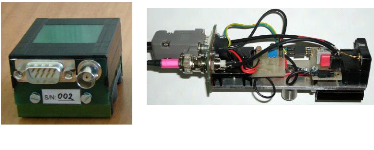4.2 Detectors
[QQL10b] The quantum channel is so powerfull, that it avoid
all attempt for eavesdropping including error in that channel, error are
related in noises for that, in our point, we will present two technologies for
quantum states detection for a QKD system.
1. Single photon detector :
We know that there exist many protocols for a QKD but for us,
we will try to take one of them which will be BB84 one of the usual protocol
used for experiment. Detectors need main elements like a single-photon detector
(SPD), photomultiplier tube (PMT) and more recently they add a new device
called superconductive single-photon detector (SSPD) for a high
performance of detection. This detector follow
(a) Receiving an incoming photon, the SPD have a efficiency
probability for detection which its determined by intrinsic quantum and
coupling losses of the detector.
(b) Dark counts are detection events registered by a SPD while
no actual photon hits it. Due to its random, the QBER contributed by dark count
event 50%.
(c) The registers of photon have an operation in the detector b,
the dead time of the single-photon sending by Alice.
(d) The detector have an output action due to the electrical
pulse in time domain. This action is fructuation of a SPD.

Figure 4.3: SPD
Figure 4.4: SPD detector composition
2. The Optical homodyne detector :
This detector used in the implementation of GMCS2
QKD protcol, there is not a difference with the classical coherent
communication system. The detector here act as follow.
(a) When the sender encode information using one of the
subfield of quantum (As this is about light);
(b) The receiver will recover the complete information;
(c) The receiver will interfering the signal with a local
oscillator;
To discover that Eve attack's, we focus on one basical
requirement of homodyne detector which is limited shot noise in the quantum
scheme. This requirement call a strong local oscillator. This
2GMCS is a one QKD protocol which mean
Gaussian-Modulated Coherent States
Section 4.2. Detectors Page 24
detector compare to SPD, the optical homodyne have a higher
efficiency and a larger bandwidth and a strong local oscillator for production
of interference. Those differences enumerated are big enough to detect in the
high speed photo diode. We must know that the detection efficiency is a
function of the wavelenght of the incoming and to build homody, we have same
challenges for implemantation in QKD.
The first challenge is to find stability of signal and local
oscillator between Alice and Bob that are from the same laser and that will
propagate through the same optical fiber. Secondly, as we said in the beginning
of this points and mention the use of GMCS QKD protocol, the balance detection
scheme is commonly employed to remove the DC background.
25
5. QKD Application
We have seen the importance of quantum cryptography and the
tools related to that field. Now, we reach the point where we will describe two
main points: the first point is on QKD applications in network and the second
point is related to databases; particularly Business Intelligence
(datawerouse). In the last section of this chapter, we will try to propose a
new application of QKD, which is to combine a data warehouse with a QKD.
| 


